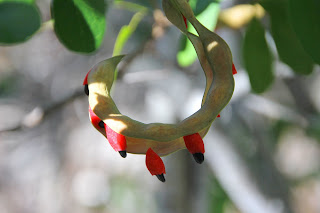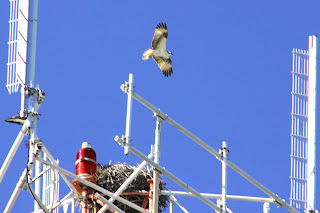Icon 1 is the departure from BSA Sea Base, and 2 is the beach at Long Key SP.
With the help of a couple paddlers, I got Ibi in the water and was second off the beach. By the time I had reached the end of the causeway, I had been overtaken by the pack, and crossed with them back under the bridge. Once we had crossed the three-mile wide channel to the east end of Long Key, we ran into a low tide grass flat. There was not enough water to float our kayaks and canoe, so we had to get out and pull our boats about 150 yards across the shoal until we again reached deeper water. The sandy bottom looked perfectly flat, but I found myself stumbling along as there were holes that I stepped into. They looked perfectly level with the rest of the bottom, but the material that filled the holes had no substance and my foot would just sink until it found firm bottom. Most were just a few inches, just enough to throw me off balance, but I fell in one and sank clear to my crotch. Oh well, that was just the price for seeing a huge red starfish.
Beach landing at Long Key State Park
This would be our second day of small craft warnings, but the wind against current flowing in the wide channel would give us our largest seas. Most 3 and 4ft. seas wouldn’t be a problem in open water, but the current produced seas that were short in period, steep faced and breaking. I tried to keep the breaking seas on my starboard quarter. When I heard one breaking behind me, I’d kick the rudder to straighten the canoe and take the sea more on my stern. On one, however, the rudder was already in white, aerated water and had no effect. I tried to paddle the canoe around, but the wave had already yawed me around sideways, and I surfed the breaking wave broadside. Now that was a ride.
Crystal-clear water and snow-white beaches.
I later learned that another paddler, coming right behind me in the same area, was undoubtedly experiencing the same conditions when he was flipped. A nearby Coast Guard Auxiliary boat quickly got him back in his boat, and he pressed on, but the capsize had caused him to lose a few minor pieces of gear. I think we were actually fairing better than the Auxiliary crew. They were anchored in a much larger boat, but the breaking sea was knocking them all over the cockpit, and I’m confident they went home with more bruises than we received. It was a short paddle today, so there was no separate landing for lunch, and we continued on to the Long Key State Park at the southeastern end of the island. The day’s paddle was 6.9 miles.
Long Key has a wonderful nature trail, and the short day gave us the chance to enjoy some new sights in the tropical hammock. After setting up camp just off the white sand beach, we got a chance to stretch our legs. The underbrush was just alive with butterflies.
Cat's Claw seed pod.
The bright red velvety seeds of the Cat’s Clay immediately caught my eye. There are several plants called Cat’s Claw, and it is being learned that some are promising in the treatment of cancer, AIDS, leukemia and other ailments.
Poison Wood tree.
The poisonwood tree is a member of the poison ivy family. Contact with virtually any part of the tree, which can grow to 60 feet, will produce a terrible rash and second-degree burns. Its smoke, or even its pollen, can carry the toxins into the eyes and lungs. The rash is a photo-toxin, meaning being in sunlight makes it worse. The sap is not water soluble, so washing with soap and water does nothing, so they recommend treating the exposed area initially with WD-40 or the juice of the sour orange. Even walking under it during a dew or rain will wash the poison onto your skin. So why not eradicate it? It is a great source of nutrition for butterflies and the almost extinct white crested pigeon. In truth, its value is just beginning to be understood.
The Gumbo-Limbo tree, or Tourist Tree.
The gumbo-limbo tree grows in the same areas that the poisonwood does, and as nature planned it, the gumbo-limbo is the antidote for the poinsonwood. The gumbo-limbo is also called the Tourist Tree, because the thin, papery bark peels like the skin of a sunburned tourist. The peeling bark can be soaked and rubbed on the poison rash, and it can be boiled to make a tea that will cure any ingestion of the poison. The gumbo-limbo is tolerant of salt, and is the most resistant of indigenous trees to wind damage, making it invaluable for protecting the low-lying Keys. It has also been used for making glue, varnish, liniments, and a coating for native canoes.
We got to see quite a few osprey, including this one flying over its nest on a microwave tower.
Mare's Tails streaming over Long Key.
The saying goes, “ Mackerel skies and mare’s tails make tall ships carry low sails,” so we knew we were in for another day of wind tomorrow. This was the lasagna night I spoke of earlier. The new caterer hadn’t known that we had had lasagna already, and apologized for the meal repetition. This stuff was so good they could have served it every night for the rest of the trip, as far as I was concerned.








No comments:
Post a Comment